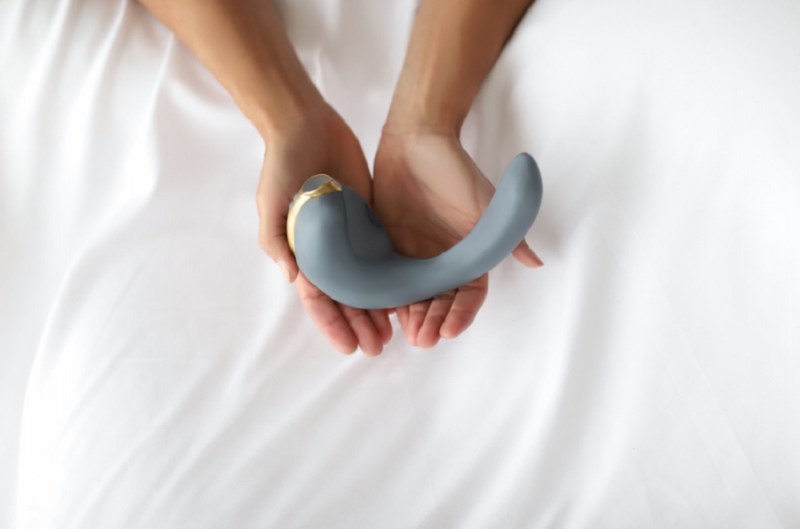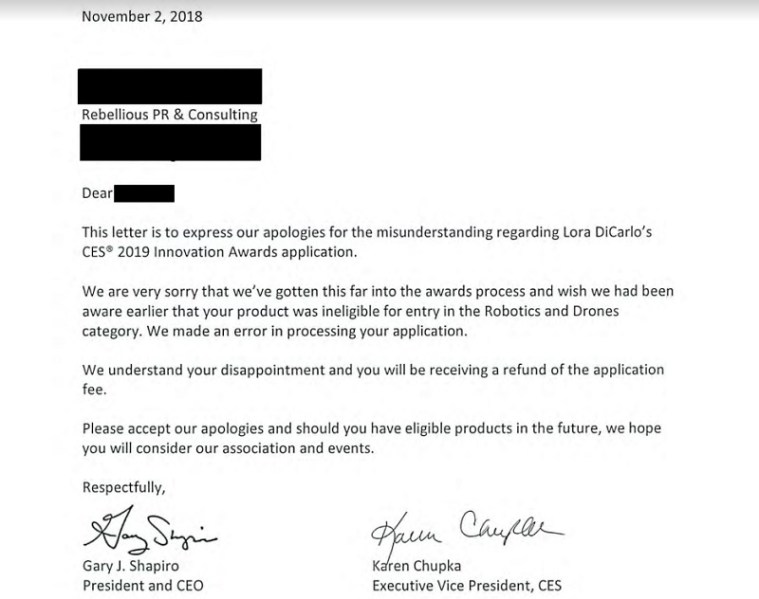The team at Lora DiCarlo was overjoyed when it received a letter from the Consumer Technology Association saying its Osé “sex positive” micro-robotic sex toy had won a CES Innovation Award, giving the company a chance to showcase itself at CES 2019, the big tech trade show in Las Vegas this week.
But Lora Haddock, founder of the company (formally known as Uccellini LLC), said the mostly female team was crushed when the CTA rescinded the award for the device, formerly called the Vela. Not only is she appealing the decision to rescind, but she is also calling out the organization for gender bias and inconsistency in addressing sex-positive women’s products versus male-oriented devices. Indeed, one of the puzzling aspects is that sex toys are not banned at CES.
“Our industry is going mainstream,” said Haddock, in an interview with VentureBeat. “We would like to expose this because it is very biased. The motivation behind this [publicity] is to see some real action and change when it comes to gender bias with CES and the tech industry. We have no delusion that we are going to get our award back. But this is an opportunity for women to stand up for themselves.”
Sarah Brown, marketing director at Lora DiCarlo, added, “There is an issue with gender bias at CES and technology, with hostility toward women and non-male participants at CES. It’s a conversation that has been going on a long time.”
June 5th: The AI Audit in NYC
Join us next week in NYC to engage with top executive leaders, delving into strategies for auditing AI models to ensure fairness, optimal performance, and ethical compliance across diverse organizations. Secure your attendance for this exclusive invite-only event.
Her company wants to raise this issue for CES, which is expected to draw 180,000 people to Las Vegas this week.
“Vela does not fit into any of our existing product categories and should not have been accepted for the Innovation Awards Program,” said spokesperson Sarah Brown (clearly not the same Sarah Brown as the one at Lora DiCarlo). “CTA has communicated this position to Lora DiCarlo. We have apologized to the company for our mistake.”
Back and forth
At first, in a letter in October, the CTA informed Lora DiCarlo that, despite the award, it could not exhibit on the show floor because of a policy that forbids “Adult” companies from doing so. (The separation of CES — formerly known as the Consumer Electronics Show — from porn makers at the Adult Entertainment Expo dates back to around 2001.)
After that conversation, CES told Lora DiCarlo in a letter that it was rescinding the award altogether, citing its discretion to disqualify entries that it deemed “immoral, obscene, indecent, profane, or not in keeping with CTA’s image.”
Then, in a letter from CTA CEO Gary Shapiro and CES executive vice president Karen Chupka, the organization apologized and withdrew the award, saying the product did not fit into any category. They said the company would be refunded its entry fees.

Above: The Osé sex toy
Haddock appealed in a letter, saying everything the company does is rooted in “sex positivity and inclusion.” In a blog post, she said, “We don’t hide what we do, and we firmly believe that women, non-binary, gender non-conforming, and LGBTQI folks should be vocally claiming our space in pleasure and tech — both of which are still heavily dominated by male-CEOs and executives. We also believe that society needs to drop the taboo around sex and sexuality — it’s a part of life and health that absolutely should be part of mainstream discourse. No shaming, no embarrassment, just the comfort and freedom to be yourself and enjoy your own body.”
She said that was the reason the company submitted its first-ever product, Osé, for the CES Innovation Awards. The hands-free device is an unapologetic sex toy, but one that is built with technology with the goal of delivering “the holy grail of orgasms — the blended orgasm.” It uses micro-robotic technology that mimics all of the sensations of a human mouth, tongue, and fingers “for an experience that feels just like a real partner.”
The product also adjusts to each body’s unique physiology for a personal fit. It was designed in partnership with Oregon State University’s robotics engineering laboratory. Osé is the subject of five pending patents and counting for robotics, biomimicry, and engineering feats.
“Putting aside for a moment the implication that women’s sexual wellness products are somehow immoral or obscene — if we didn’t fit their policy, how in the world did our application even get past the first round of vetting by CTA staff, let alone receive high marks across the board from their expert judges?” Haddock asked.
Unequal treatment

Above: Letter from CTA to Lora DiCarlo.
Lora DiCarlo’s legal team followed up with a letter saying that CES “has had no problem allowing explicitly pornographic products for men.” In 2018, CES allowed the porn company Naughty America to display a sign on the exhibition floor that proclaimed, “The Future of Adult Entertainment is Here.” Naughty America was also present in 2017 in a meeting room at the back of the South Hall of the Las Vegas Convention Center at CES 2017.
Naughty America CEO Andreas Hronopoulos said in an interview with VentureBeat that his company has only a meeting room at CES 2019, where it is showing off technology that captures strippers and allows people to view them in the privacy of their own home using augmented reality technology. His company does not have a booth to exhibit any of its VR porn.
Lora DiCarlo further argued:
In 2016, a French company, B.sensory, was a CES Innovation Awards Honoree for an e-book-driven vibrator sex toy. In 2016, OhMiBod was named winner of the “Digital Health and Fitness Product” category at the International CES 2016 “Best of CES Awards” for its product, Lovelife Krush Kegel exerciser and vibrator. OhMiBod has exhibited at CES for many years.
Additionally, CES has had no problem allowing explicitly pornographic products for men, such as Naughty America’s virtual reality porn product, and Abyss Creations’ RealDoll, Solana, the hands-on sex robot for men.
The dearth of female representation in tech at CES has given rise to terms like ‘brogrammer,’ inspired books like Emily Chang’s ‘Brotopia’, and prompted the creation of the hashtag: #CESSoMale. … I implore you to make the right decision; be a part of the solution, not the problem. I hope that we can resolve this in a positive manner and the CTA recognizes innovation — regardless whether the source is men or women.
Lora DiCarlo said it could find only one female-founded company that has won the Best of CES Innovation Award in the past five years.
Haddock added, “Men’s sexuality is allowed to be explicit with a literal sex robot in the shape of an unrealistically proportioned woman and VR porn in point of pride along the aisle. Female sexuality, on the other hand, is heavily muted if not outright banned. You cannot pretend to be unbiased if you allow a sex robot in the shape of an unrealistic female body but not a vagina-focused robotic massager for blended orgasm. This double standard makes it clear that women’s sexuality is not worthy of innovation.”
The Lora DiCarlo team isn’t arguing for naked women and scantily clad booth babes to return to CES (they’re mostly gone), like in the days before the split with the porn industry. But they do believe that “sex positive” products are going mainstream, like the massagers you can buy in Brookstone stores.
“I’m not talking present tense on booth babes, but it’s important to point out the history,” Brown said.
Initial skepticism

Above: Lora DiCarlo is a brand for Uccellini LLC.
Haddock said that when Uccellini first approached OSU’s College of Engineering with the proposition for developing this device, there was, of course, some initial skepticism. But after Haddock explained the years of scientific data she had collected, the concept, the need, and the type of female-centric marketing the company would use for such a product, that skepticism vanished.
Furthermore, when the senior male engineering faculty at OSU saw how enthusiastic many of their female engineering students were to work on this project, they realized how positive it could be for the university’s image, Haddock said.
The micro-robotics led the team to biomimicry, or mimicry of human motion. That eliminated the need for vibration. (Yes, it’s not really a vibrator.) It’s more like a partner moving, said Haddock.
“That’s far more effective than using vibration,” she said. “It moves in the right way and hits the right places and can fit each individual user. Robotics is absolutely essential for this product. We don’t call it a vibrator.”
Haddock said that, after being notified of the CES award, Uccellini also had communications with a number of potential investors in the company, letting them know that the award validated the company’s faith in the engineering and technology behind the device. The reaction from potential investors was quite positive, which is critical to the prospects for a young startup preparing to market its first product.
“In the startup world, women don’t have as much opportunity to get funding,” Haddock said. “Women keep their mouth shut about that. It’s dangerous for them to talk about it.”
Haddock and her lawyer Kenneth Bass argued, “There is certainly nothing immoral about a device aimed at women’s sexual health unless CTA is regressing more than 100 years to an era when women’s sexuality was taboo. Such devices are legal for sale in the United States, and a major public university had no problem using its resources to develop it. The device is also not obscene — it is simply an electronic device with the proper anatomical dimensions to function. It is not in a sexually suggestive or exaggerated shape or color. Indeed, one of the advances of the Lora DiCarlo device is that it is anatomically correct for its purpose, thereby making it smaller than most other uni-functional stimulation devices, and thus presenting an engineering challenge to fit in the necessary electronic components.”
As for the giant conference, it isn’t necessarily a total loss. Lora DiCarlo will be able to show its goods at the Showstoppers Party at the Wynn Hotel in Las Vegas on Tuesday evening during CES. Hundreds of CES vendors will be there, as well as the press. And Lora DiCarlo will also attend AVN, the porn show that takes place in Las Vegas at the end of January. Haddock thinks CES is missing out in that respect, as sex toys are expected to be a $30 billion category by 2021, according to Technazio.
Brown said that it would be better to have the mainstream attention. For instance, it would be great if a sex-positive product with robotics could show up in the robotics section at CES, rather than in a section of the show reserved for sex and porn, or at a sex trade show like AVN.
“When I found out about this rescinding, the big thing I took away is that you are not good enough,” Brown said. “This area of health and sexuality is not worthy of innovation. This is very specifically about women’s sexual health. This is not about explicit sexuality. Our brand is not using extreme nudity. But this says female sexuality is not worthy. We want to extend this conversation for women in technology.”


